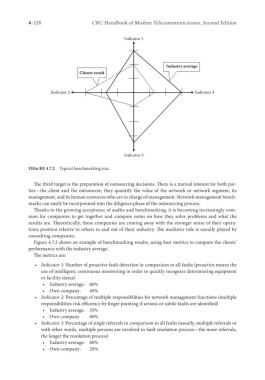Page 597 - Handbook of Modern Telecommunications
P. 597
4-128 CRC Handbook of Modern Telecommunications, Second Edition
Indicator 1
Industry average
Clients result
Indicator 2 Indicator 4
Indicator 3
FIGu RE 4.7.2 Typical benchmarking star.
The third target is the preparation of outsourcing decisions. There is a mutual interest for both par-
ties—the client and the outsourcer; they quantify the value of the network or network segment, its
management, and its human resources who are in charge of management. Network management bench-
marks can easily be incorporated into the diligence phase of the outsourcing process.
Thanks to the growing acceptance of audits and benchmarking, it is becoming increasingly com-
mon for companies to get together and compare notes on how they solve problems and what the
results are. Theoretically, these companies are coming away with the stronger sense of their opera-
tions position relative to others in and out of their industry. The mediator role is usually played by
consulting companies.
Figure 4.7.2 shows an example of benchmarking results, using four metrics to compare the clients’
performance with the industry average.
The metrics are:
• Indicator 1: Number of proactive fault detection in comparison to all faults (proactive means the
use of intelligent, continuous monitoring in order to quickly recognize deteriorating equipment
or facility status)
• Industry average: 60%
• Own company: 40%
• Indicator 2: Percentage of multiple responsibilities for network management functions (multiple
responsibilities risk efficiency by finger pointing if serious or subtle faults are identified)
• Industry average: 35%
• Own company 60%
• Indicator 3: Percentage of single referrals in comparison to all faults (usually, multiple referrals or
with other words, multiple persons are involved in fault resolution process—the more referrals,
the longer the resolution process)
• Industry average: 80%
• Own company: 20%

